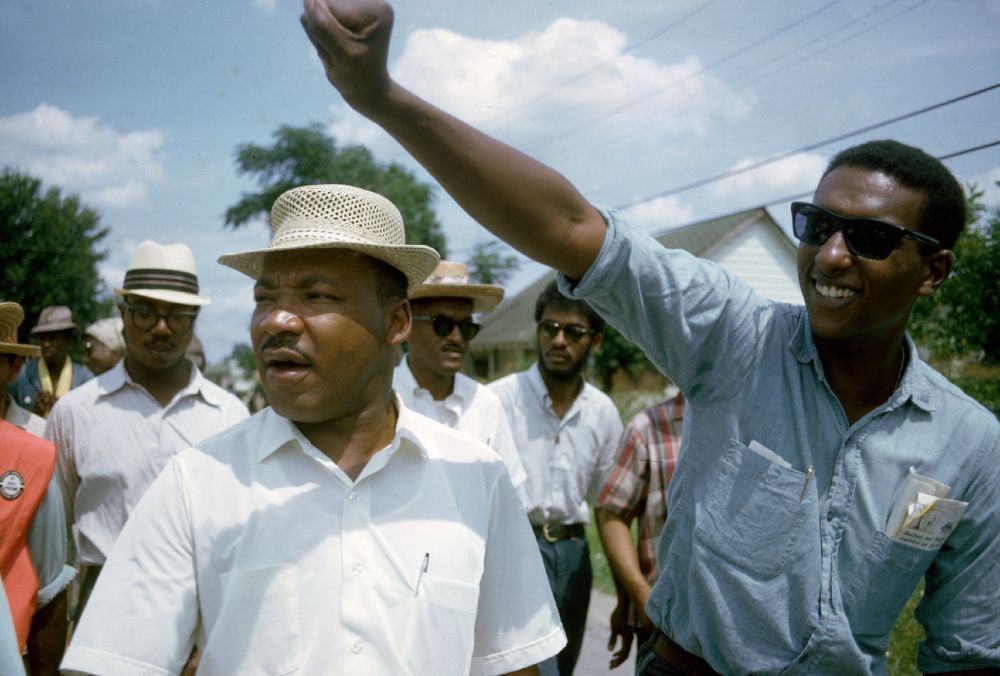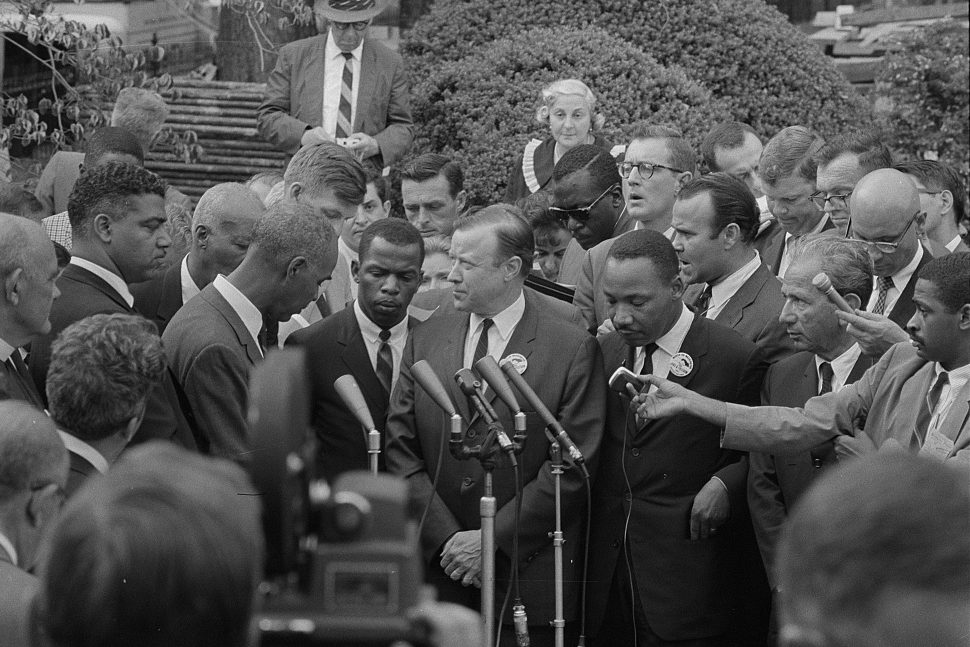Martin Luther King Jr. and the Tradition of Radical Blackness

This year marks the 50th anniversary of not only Martin Luther King Jr.’s April 4, 1968 assassination, but also the massive uprisings in protest of this world-historical tragedy. King’s slaying proved to be a catalyst for a number of insurgencies, including the organization of Black labor into the League of Revolutionary Black Workers in May of that year and the Black Power salute given by Tommie Smith and John Carlos at the Olympics that October. It was also a flashpoint for the Black student movement on the campuses of U.S. colleges and universities for, among other things, a more relevant education through the creation of Black Studies. The routinized repression of King and other Black activists galvanized college students to demand curricula and institutions that would provide them with skills to develop and defend their communities.
Most people are familiar with King’s iconic August 28, 1963, “I Have a Dream” speech. Most people have also been bombarded with the worn platitudes that have emanated from the abstraction of his ideas therein. Many have offered that King dreamed of a post-racial, neoliberal, multicultural society in which race ceased to be a topic of discussion, and more importantly, a source of disruption and discontent. Most people who believe this mythology ignore his lament that “the Negro lives on a lonely island of poverty in the midst of a vast ocean of material prosperity,” but celebrate his dream that “little black boys and black girls will be able to join hands with little white boys and white girls as sisters and brothers.” Simply put, many are invested in the distortion of King’s lofty dream into a commodifiable fantasy.
As early as 1964, King was aware that the civil rights movement was an incomplete insurgency, and that its bourgeois liberal specifications had not improved the plight of the overwhelming majority of Black people, especially those warehoused and contained in dispossessed urban enclaves. On November 14 of that year, he addressed the Southern Christian Leadership Conference (SCLC), enjoining that the “Golden Age” of the civil rights movement, “did not accomplish everything… These legislative and judicial victories did very little to improve the lot of millions of Negroes in the teeming ghettos of the North. The changes that came about during this period were at best surface changes; they were not really substantive changes.” Like the multitude of earlier Black progressives who shaped the tradition of radical Blackness, King acknowledged the centrality of racialized economic justice to “getting free.” The “tradition of radical blackness,” as opposed to Cedric Robinson’s “Black radical tradition,” underscores the centrality of political economic, structural, and material critiques of racialized forms of dispossession.

The tradition of radical blackness can be understood as the internationalist and leftist articulation of anti-colonialist, anti-capitalist, antiracist, antiwar, and anti-imperialist conjunctures that aim to dismantle structures of domination that sustain racialized dispossession and exploitation. Its preeminent objective is to imagine and bring into being liberatory possibilities for all oppressed people. It reveals the temporal and spatial linkages among African descendants wherever they are located. Additionally, statist authorities have variously targeted this progressive praxis as communism, socialism, extremism, authoritarianism, and terrorism. Such attacks are used to rationalize the use of extraordinary force, violence, and exclusion.
King was not immune to the violence of the U.S. state. His Federal Bureau of Investigation file contains thousands of pages that reveal extensive wiretapping of his phone, bugging of his home and hotel rooms, arrests on trumped up charges, and unrelenting forms of scrutiny and surveillance. Other Black radicals who were subjected to this form of extreme repression include Shirley Graham and W.E.B. Du Bois, Eslanda and Paul Robeson, Louise Thompson and William Patterson, Vicki Garvin, Marvel Cooke, and Claudia Jones.
Three major tenets of King’s political thought put him squarely in the tradition of radical blackness: his critique of liberalism; his understanding of Black revolution in the United States as a part of the world revolution; and the inextricability of racism, war, and economic exploitation.
In his 1963 “Letter from a Birmingham Jail,” King expressed his disappointment in white liberalism. He asserted that, in many ways, it was the greatest stumbling block in the journey for Black equality, insofar as it proffered and preferred order and the absence of tension to real justice for Black people. King had little time for those who “constantly sa[id]: ‘I agree with you in the goal you seek, but I cannot agree with your methods of direct action’… [and] who paternalistically believe[d] he c[ould] set the timetable for another man’s freedom.” In 1967, he lamented in Why We Can’t Wait that white Americans chose to believe that U.S. society was a level playing field that allowed for all races to reach middle-class status and racial harmony. Such belief, he asserted, was not only a fantasy of “self-deception and comfortable vanity,” but also undermined their commitment to justice for Black folk.
However, Black Cold War liberalism was just as pernicious as white liberalism. The conjuncture of what historian Gerald Horne calls the “red scare” and the “Black scare” caused Black leaders such as Max Yergan and Walter White to turn away from radical activism, and to adopt strategies and rhetoric that could not be construed as communist. Indeed, they seized upon the opportunity to improve their condition in keeping with demands consistent with the pedagogy of the Cold War state. The emphasis on symbolic racial progress, meritocracy, and promoting on the international stage the idea that U.S. racism was a thing of the past was very much in line with the Cold War state’s shift to an antiradical policy of antiracism. Such an approach allowed Black civil rights to become disentangled in the popular mind from Communist agitation, while rationalizing the suppression and discrediting of the tradition of radical blackness.

On April 4, 1967, a year to the day before he was assassinated, King gave a speech entitled “Beyond Vietnam.” In it, he enunciated the struggle for Black freedom as part of the global struggle to build a new society oriented around peace, prosperity, and people over profit. King was convinced that, “if we are to get on to the right side of the world revolution, we as a nation must undergo a radical revolution of values…. We must rapidly begin the shift from a thing-oriented society to a person-oriented society. When machines and computers, profit motives and property rights, are considered more important than people, the giant triplets of racism, extreme materialism, and militarism are incapable of being conquered.”
His statements are reminiscent of those of Black Communist leader Harry Haywood, who in 1933 insisted, “In the present epoch of imperialism and proletarian revolution the Negro question in the United States must be conceived as part of the national colonial problem, or, in other words, it is part of the general world-wide problem of freedom of the oppressed and dependent peoples from the shackles of imperialism.” Likewise, in 1927, Harlem-based Black militant and one-time Garveyite Richard B. Moore asserted that systems of suppression and subjugation could only be overcome through racial equality, the right to education, the organization of political and economic power for Black people, and the coordination of worldwide liberation movements.
In his “Beyond Vietnam” speech, King offered the inextricability of war, racism, and capitalist exploitation. He stated, “A nation that will keep people in slavery for 244 years will ‘thingify’ them, make them things. Therefore they will exploit them, and poor people generally economically…. And a nation that will exploit economically will have to have foreign investments. And will have to use its military might to protect them. All of these problems are tied together.” Here, King was following in the footsteps of W.E.B. Du Bois, for whom peace meant the end of imperialism, the achievement of self-determination, the eradication of apartheid and Jim Crow segregation, and “decent and humane” material and social conditions for all. Indeed, in 1947 he proclaimed, “The emancipation of the black masses of the world is one guarantee of a firm foundation in world peace.”1 For this radical Black internationalist pacifism, Du Bois was indicted, tried, and ultimately acquitted in 1951.
Martin Luther King Jr. did not only have a dream. He also had a vision that inhered in a deep yearning for the comprehensive transformation of American–and global–society. Such society would be devoid of racialized inequality, narrow nationalism rooted in militarism, war mongering, capitalist exploitation, and the wanton disregard of Black suffering. This vision orients King toward the tradition of radical blackness, despite attempts by the ruling class to sanitize his legacy.
- W.E.B. Du Bois, “The Winds of Time,” Chicago Defender (January 11, 1947). ↩
